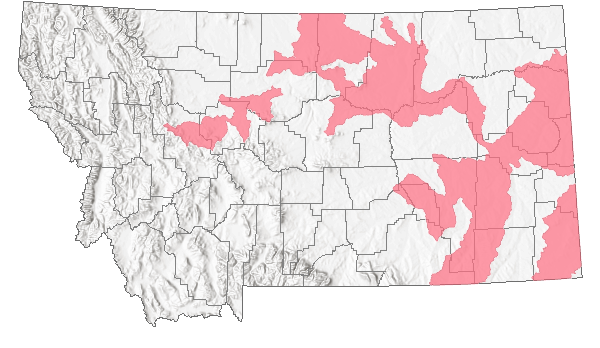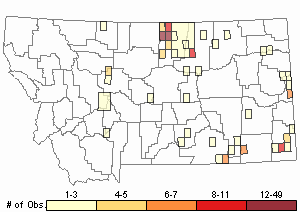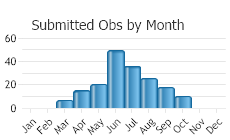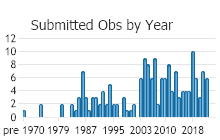View in other NatureServe Network Field Guides
NatureServe
Montana
Utah
Wyoming
Idaho
Wisconsin
British Columbia
South Carolina
Yukon
California
New York
Golden Shiner - Notemigonus crysoleucas
General Description
The golden shiner is an introduced species that has been stocked into ponds and has escaped into slow running streams and rivers east of the Continental Divide in Montana. It was probably introduced into our state as a forage fish or as the result of bait fishing. Pond culture of the golden shiner for bait is a moderately large industry in the south-central U.S. They can grow to lengths of about 8 inches. Golden shiners prefer habitat with abundant aquatic vegetation and eat plant as well as animal matter. They are easily caught on bait or artificial flies.
Diagnostic Characteristics
Adults golden; color fades rapidly when removed from water. Young silvery with dusky midside band. Body deep and flat-sided, front of dorsal fin well behind front of pelvic fins. Head small and triangular.
Species Range
Montana Range
Range Descriptions

 Non-native
Non-native
Range Comments
The golden shiner is native throughout the eastern half of North America, north to the St Lawrence River, Great Lakes, and Lake Winnipeg, and west to the Dakotas and Texas. Because of its use as bait, it has also been introduced in many places outside this native range.
Observations in Montana Natural Heritage Program Database
Number of Observations: 188
(Click on the following maps and charts to see full sized version)
Map Help and Descriptions
Relative Density

Recency



 (Observations spanning multiple months or years are excluded from time charts)
(Observations spanning multiple months or years are excluded from time charts)
Habitat
Weedy ponds and lakes, slow moving streams.
Food Habits
Feeds largely on zooplankton. Aquatic insects and vegetation are also important. Larger individuals will eat snails and small fish.
Ecology
Has been used as a forage fish in stocking programs. Female is generally larger than the male.
Reproductive Characteristics
Sexually mature in 2 years. Spawns May - Aug. depending upon the temperature.
Management
Stewardship Responsibility
References
- Additional ReferencesLegend:
 View Online Publication
View Online Publication
Do you know of a citation we're missing? Barfoot, C.A. 1993. Longitudinal distribution of fishes and habitat in Little Beaver Creek, Montana. M.Sc. Thesis. Bozeman, MT: Montana State University. 66 p.
Barfoot, C.A. 1993. Longitudinal distribution of fishes and habitat in Little Beaver Creek, Montana. M.Sc. Thesis. Bozeman, MT: Montana State University. 66 p. Barfoot, C.A. and R.G. White. 1999. Fish assemblages and habitat relationships in a small northern Great Plains stream. The Prairie Naturalist 31(2):87-107.
Barfoot, C.A. and R.G. White. 1999. Fish assemblages and habitat relationships in a small northern Great Plains stream. The Prairie Naturalist 31(2):87-107. Clancey, C.G. 1978. The fish and aquatic invertebrates in Sarpy Creek, Montana. M.Sc. Thesis. Bozeman, MT: Montana State University. 54 p.
Clancey, C.G. 1978. The fish and aquatic invertebrates in Sarpy Creek, Montana. M.Sc. Thesis. Bozeman, MT: Montana State University. 54 p. Duncan, M.B. 2019. Distributions, abundances, and movements of small, nongame fishes in a large Great Plains river network. Ph.D. Dissertation. Bozeman, MT: Montana State University. 255 p.
Duncan, M.B. 2019. Distributions, abundances, and movements of small, nongame fishes in a large Great Plains river network. Ph.D. Dissertation. Bozeman, MT: Montana State University. 255 p. Joslin, Gayle, and Heidi B. Youmans. 1999. Effects of recreation on Rocky Mountain wildlife: a review for Montana. [Montana]: Montana Chapter of the Wildlife Society.
Joslin, Gayle, and Heidi B. Youmans. 1999. Effects of recreation on Rocky Mountain wildlife: a review for Montana. [Montana]: Montana Chapter of the Wildlife Society. Knight, D.E. 1982. Accumulation of dietary methylmercury by Walleye and White Crappie in the Tongue River Reservoir, Montana. M.Sc. Thesis. Bozeman, Montana: Montana State University. 103 p.
Knight, D.E. 1982. Accumulation of dietary methylmercury by Walleye and White Crappie in the Tongue River Reservoir, Montana. M.Sc. Thesis. Bozeman, Montana: Montana State University. 103 p. Penkal, R.F. 1977. Black bass populations of the Tongue River Reservoir, Montana. M.Sc. Thesis. Bozeman, MT: Montana State University. 111 p.
Penkal, R.F. 1977. Black bass populations of the Tongue River Reservoir, Montana. M.Sc. Thesis. Bozeman, MT: Montana State University. 111 p. Stringer, A.L. 2018. Status of Northern Pearl Dace and chrosomid dace in prairie streams of Montana. M.Sc. Thesis. Bozeman, MT: Montana State University. 150 p.
Stringer, A.L. 2018. Status of Northern Pearl Dace and chrosomid dace in prairie streams of Montana. M.Sc. Thesis. Bozeman, MT: Montana State University. 150 p. Wollitz, R.E. 1958. The effects of certain commercial toxicants on limnology of 3 cold water ponds near Three Forks, Montana. M.Sc. Thesis. Bozeman, MT: Montana State University. 63 p.
Wollitz, R.E. 1958. The effects of certain commercial toxicants on limnology of 3 cold water ponds near Three Forks, Montana. M.Sc. Thesis. Bozeman, MT: Montana State University. 63 p. Zymonas, N.D. 2006. Age structure, growth, and factors affecting relative abundance of life history forms of Bull Trout in the Clark Fork river drainage, Montana and Idaho. M.Sc. Thesis. Bozeman, MT: Montana State University. 142 p.
Zymonas, N.D. 2006. Age structure, growth, and factors affecting relative abundance of life history forms of Bull Trout in the Clark Fork river drainage, Montana and Idaho. M.Sc. Thesis. Bozeman, MT: Montana State University. 142 p.
- Web Search Engines for Articles on "Golden Shiner"
- Additional Sources of Information Related to "Fish"





